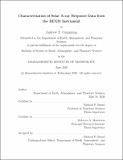Characterization of solar X-ray response data from the REXIS instrument
Author(s)
Cummings, Andrew T.
Download1191838987-MIT.pdf (4.952Mb)
Other Contributors
Massachusetts Institute of Technology. Department of Earth, Atmospheric, and Planetary Sciences.
Advisor
Richard P. Binzel and Rebecca A. Masterson.
Terms of use
Metadata
Show full item recordAbstract
The REgolith X-ray Imaging Spectrometer (REXIS) is a student-built instrument that was flown on NASA's Origins, Spectral Interpretation, Resource Identification, Safety, Regolith Explorer (OSIRIS-REx) mission. During the primary science observation phase, the REXIS Solar X-ray Monitor (SXM) experienced a lower than anticipated solar x-ray count rate. Solar x-ray count decreased most prominently in the low energy region of instrument detection, and made calibrating the REXIS main spectrometer difficult. This thesis documents a root cause investigation into the cause of the low x-ray count anomaly in the SXM. Vulnerable electronic components are identified, and recommendations for hardware improvements are made to better facilitate future low-cost, high-risk instrumentation.
Description
Thesis: S.B., Massachusetts Institute of Technology, Department of Earth, Atmospheric, and Planetary Sciences, May, 2020 Cataloged from the official PDF of thesis. Includes bibliographical references (pages 67-68).
Date issued
2020Department
Massachusetts Institute of Technology. Department of Earth, Atmospheric, and Planetary SciencesPublisher
Massachusetts Institute of Technology
Keywords
Earth, Atmospheric, and Planetary Sciences.